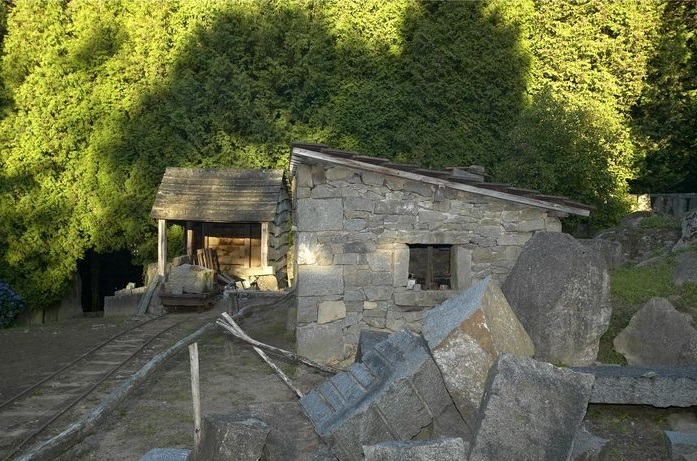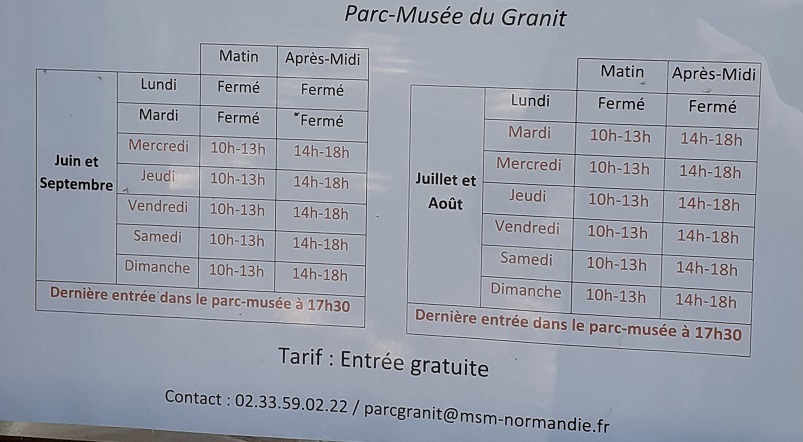
Cette earth nécessite l'accès au parc-musée du granite.
L'entrée est gratuite.
Renseignez-vous sur les horaires (coordonnées ci-dessous).

[horaires été 2020]

click on the flag to reach the translation

Une Earthcache
Il ne s’agit pas d’une cache physique. Pour loguer cette cache, vous devez dans un premier temps prendre connaissance de sa description éducative en matière de géologie, puis d’observer le site sur lequel vous êtes, et enfin de répondre aux questions qui vous seront posées.
Vous pourrez alors loguer en "Found it" sans attendre mais vous devez me faire parvenir vos réponses en même temps en me contactant soit par mail dans mon profil, soit via la messagerie geocaching.com (Message Center), et je vous contacterai en cas de problème. Les logs enregistrés sans réponses seront supprimés.

Un peu de géologie
3 grands types de roches
Les géologues classent les roches en fonction de leur origine et de leur composition.
- Les roches magmatiques proviennent du refroidissement d'un magma. Elles sont qualifiées de volcaniques quand elles se forment lors des éruptions à la surface de la Terre, ou de plutoniques quand elles refroidissement et cristallisent en profondeur.
- Les roches sédimentaires naissent à la surface, généralement par dépôt de matériaux au fond d’une mer, sur la côte, dans un delta, ou, plus rarement, à la surface d’un continent. Ces matériaux, les sédiments, proviennent de l’érosion des autres roches.
- Les roches métamorphiques correspondent à d'anciennes roches préexistantes, magmatiques, sédimentaires ou déjà métamorphisées et qui ont été transformées, en profondeur, par augmentation de pression et de température, le plus généralement dans le contexte de la formation d'une chaîne de montagnes.
Le grès
Le grès est une roche sédimentaire détritique, issue de l’agrégation de grains de taille majoritairement sableuse (0,06 mm à 2 mm) et consolidé lors de la cimentation (appelée diagénèse). Les grains constituant le grès sont issus de l'érosion de roches préexistantes qui déterminent en grande partie sa composition, principalement constitué de quartz et feldspath. Selon le degré de cimentation et sa composition, il peut s'agir d'une roche très friable à cohérente. On trouve une grande variété de milieux où ce sont déposés des grès, depuis le domaine continental (rivière, plage) au domaine marin (turbidites). Son équivalent non consolidé est généralement appelé sable.
Le schiste
Un schiste est une roche métamorphique qui a pour particularité d'avoir un aspect feuilleté, et de se débiter en plaques fines ou « feuillet rocheux ». On dit qu'elle présente une schistosité. Elle se caractérise par un grain très fin, invisible à l’œil nu ce qui fait qu'on dit qu'il s'agit d'une roche non grenue, à l'aspect lisse au toucher.
Le calcaire
Les calcaires sont des roches sédimentaires, tout comme les grès ou les gypses, facilement solubles dans l'eau. Le calcaire est la base de nombreux matériaux.
- Lorsque la roche comporte une proportion non négligeable d'argile, on parle plutôt de marne.
- La craie est une roche calcaire formée par une accumulation de squelettes calcaires des microalgues et animaux marins.
- Le tuffeau est de la craie sableuse à grain fin, de couleur blanche ou crème parfois jaunâtre, contenant quelques paillettes de mica blanc.
- La calcite est le polymorphe (cristalisation) d'origine secondairement géologique du carbonate de calcium. Le polymorphe d'origine primairement biogénique étant l'aragonite (exemple: le squelette des coraux).
Le granite
Le granite n'est pas une roche sédimentaire mais une roche plutonique magmatique à texture grenue, résultat du refroidissement lent de grandes masses de magma. Sa texture est grenue, riche en quartz, feldspaths, micas.
Le gneiss
Le gneiss est une roche métamorphique présentant une alternance de lits clairs et foncés : les premiers sont constitués de cristaux blancs, gris ou rose de quartz et de feldspath de taille moyenne, tandis que les seconds, noirâtres, sont riches en éléments ferro-magnésiens (micas, amphiboles, hornblende).
Questions
Question 0 - Prenez une photo de vous, ou de votre objet distinctif de géocacheur, ou de votre pseudo écrit sur une feuille de papier ou dans votre main... devant l'entrée du musée, et joignez-là à votre log ou à vos réponses
Question 1 - Vous avez devant vous 3 fragments de roche. Notons-les A (à gaiche en regardant depuis le chemin), B (central) et C (à droite). Décrivez successivement chacun des fragments en terme de couleur, granularité, dureté, présence apparente de cristaux, ...
Question 2 - Pour chacun de ces fragments, sont-ils d'origine magmatique, sédimentaire ou métamorphique (justifiez votre réponse) - Vous ne devez pas partir de la réponse (Q3-Q4) pour réaliser par déduction l'observation Q2, c'est plutôt le cheminement inverse qui vous est demandé
Question 3 - Lequel de ces fragments est sans aucun doute possible du granite ?
Question 4 - Les 2 autres fragments correspondent à des roches présentées dans la leçon, quelles sont-elles ?
Les réponses ne se hasardant qu'à identifier les roches sans proposer une observation détaillée de ces fragments, objectif de cette earthcache, ne seront pas acceptées.


An Earthcache
It is not a physical cache. To log this cache, you must first learn about its educational description in geology, then observe the site on which you are, and finally answer the questions that will be asked.
You can then log in "Found it" without waiting but you must send me your answers at the same time by contacting me either by mail in my profile, or via the messaging geocaching.com (Message Center), and I will contact you in case of problem. Saved logs without answers will be deleted.

A little of geology
3 major rock types
Geologists classify rocks according to their origin and composition.
- Magmatic rocks come from the cooling of a magma. They are called volcanic when they form during eruptions on the Earth’s surface, or plutonic when they cool and crystallize in depth.
- Sedimentary rocks are formed on the surface, usually by depositing material at the bottom of a sea, on the coast, in a delta, or, more rarely, on the surface of a continent. These materials, the sediments, come from the erosion of other rocks.
- Metamorphic rocks correspond to old pre-existing, magmatic, sedimentary or already metamorphized rocks which have been transformed, in depth, by increasing pressure and temperature, most generally in the context of the formation of a mountain range.
Sandstone
Sandstone is a detrital sedimentary rock, resulting from the aggregation of mainly sandy grains (0.06 mm to 2 mm) and consolidated during cementation (called diagenesis). The sandstone grains are derived from the erosion of pre-existing rocks that largely determine its composition, mainly quartz and feldspar. Depending on the degree of cementation and its composition, it can be a very friable to consistent rock. There is a wide variety of environments where sandstone is deposited, from the continental domain (river, beach) to the marine domain (turbidites). Its unconsolidated equivalent is usually called sand.
Shale
A shale is a metamorphic rock that has the particularity of having a laminated appearance, and to be sold in thin plates or "rocky sheet". It is said to have schistosity. It is characterized by a very fine grain, invisible to the naked eye so that it is said that it is a non-grained rock, smooth to the touch.
Limestone
Limestones are sedimentary rocks, just like sandstones or gypsums, easily soluble in water. Limestone is the basis of many materials.
- When the rock has a significant proportion of clay, it is called marl.
- Chalk is a limestone rock formed by an accumulation of calcareous skeletons of microalgae and marine animals.
- The tuffeau is fine-grained sand chalk, white or cream sometimes yellowish color, containing some flakes of white mica.
Calcite is the polymorphic (crystallization) of secondarily geological origin of calcium carbonate.The polymorph of originally biogenic origin being aragonite (example: the skeleton of corals).
Granite
Granite is not a sedimentary rock, but a magmatic plutonic rock with a grainy texture, a result of the slow cooling of large masses of magma. Its texture is grainy, rich in quartz, feldspars, micas.
Gneiss
Gneiss is a metamorphic rock with alternating light and dark beds: the first consist of white crystals, gray or pink of quartz and feldspar of medium size, while the second, blackish, are rich in ferro-magnesian elements (micas, amphiboles, hornblende).
Questions
Question 0 - Take a picture of yourself, or your distinctive geocacher object, or your nickname written on a piece of paper or in your hand... at the entry of the park-museum, and attach it to your log or your answers
Question 1 - You have in front of you 3 fragments of rock. note them A (left looking from the path), B (central) and C (right. Describe each of the fragments in turn in terms of color, granularity, hardness, apparent presence of crystals, ...
Question 2 - For each of these fragments, are they of magmatic, sedimentary or metamorphic origin (justify your answer) - You do not have to start from the answer (Q3-Q4) to carry out the observation Q2 by deduction, it is rather the reverse process which is asked of you
Question 3 - Which of these fragments is undoubtedly granite?
Question 4 - The other 2 fragments correspond to rocks presented in the lesson, what are they?
Answers only venturing to identify rocks without offering a detailed observation of these fragments, the objective of this earthcache, will not be accepted.